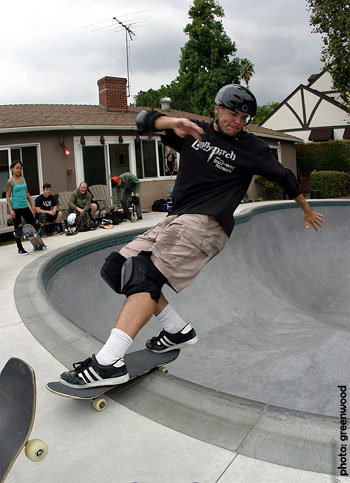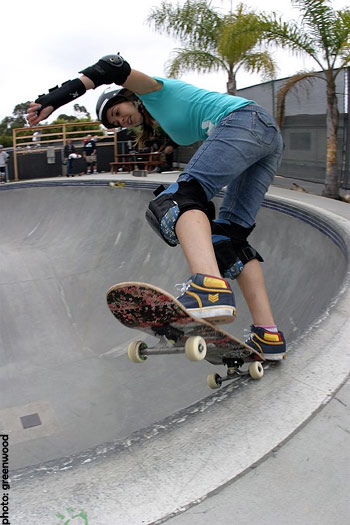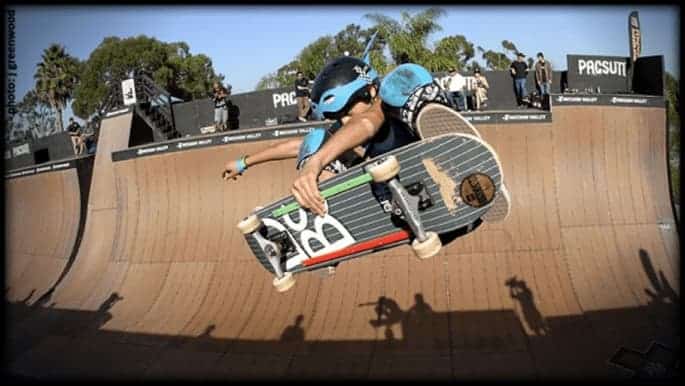Exposing UnderExposed
Intro: It seems like there’s a million videos coming at you and me every day now that the internet has flourished. The vast majority of these don’t bring much more to the table other then new faces and hammer tricks. Even the best skate movies these days are resorting to circus tricks with explosions and special effects in order to stand out. There are also a seemingly endless supply of skateboard documentaries to choose from and they have gotten pretty stale and repetitive with there cast of characters. UNDEREXPOSED has a bit of a different flavor to it. It might make you re-think what is going on out in skateboard media land. Lack of girls skateboarding in the major league mags is rampant to the degree that I think I can count on one hand how many ladies have had a picture in a major skatemag on one hand over 30 years. That is piss poor!
I think the girls scene has been percolating for many years now and it might just bust out of the back stage. I think the ladies are taking the right track and doing it themselves. This movie is helping to play a part in that without question. So I felt I had to get into their heads and find out more about what they learned along the way. Brian Lynch and Amelia Brodka were kind enough to take some time to thoroughly answer a bunch of questions I put together to find out about their film making experience.
They are currently making screenings of the movie wherever possible. I would like to encourage you all to see it if you have a chance.

When did this movie germinate? (Come into being?)
Spring of 2011. Amelia and I met while I was filming Hannah Fontana with Julie Kindstrand. She asked me if I knew anything about documentaries and told me she wanted to do one on women’s skateboarding. We talked about some films to look at and what approach she’d like to take. Once Hannah Fontana came out she asked me to tutor her in video production. On our second dry run she told me about her X-Games experience and I saw the whole movie. I knew it was a story I wanted to help tell.
When did it complete?
Late July 2012. We had a preview screening in August at Agenda in Long Beach. Since then there have only been minor changes like color and sound. I doubt anyone who saw it that night would notice anything different about it as it is now. However, it seems so much has been happening so fast that the version we’ve been showing is already dated. We have an alternate ending for the eventual video release, covering Exposure 2012, Alana’s 540 and the addition of women’s park for X-Games Barcelona.
In the time of development, what kind of events changed your course?
The subjects we wanted to cover stayed pretty consistent throughout. Telling Amelia’s story is where we had some twists and turns, primarily having her agree to have her story be told at all We had a test screening at USC that was just the interview stuff and, much to her chagrin, everyone wanted more of Amelia’s story. We really didn’t know how David Everly would fit in, but he turned out to be an amazing part of the movie. Finally getting Lisa Whitaker to agree to be on camera was big which set us up for the ending which we had no idea was going to happen when we shot it.
What kind of equipment was the movie made with?
An HVX-200 (Priscilla), a Canon 7D (Patricia), and a GoPro or two that we borrowed. But that’s just that stuff that we filmed. There’s tons of footage we got from people like Lisa Whitaker, Don Brown and Ed Templeton. We edited in Final Cut 7.
Was there any trouble getting access to industry people to talk about this?
It was so much easier than we expected. One of the versions of the movie I imagined when we first talked about it was Roger & Me (where Michael Moore is trying to track down the CEO of GM). I pictured Amelia trying to hound industry folks into talking about it and having doors slammed in her face. A year later we had both the editors of Thrasher and Transworld not only in our movie, but stoked to talk to us about it. We owe a great debt of gratitude to Mimi Knoop and Don Brown for connecting us with so many of our interviewees.
Was there any people you were unable to interview that you think would have made it better?
We did some schedule dancing with Jamie Thomas who would’ve added more insight into Elissa Steamer and her journey, Jeff Grosso who can’t help but be hilarious and Christian Hosoi who we got to do an intro for our GIrls Combi Classic recap. Unfortunately we couldn’t make it work to get any of them for the movie. There were also a few pro street skater girls that we tried to reach but couldn’t really nail down. All told there are over 30 people that talk in this film and we didn’t even use every interview we did.
Did your initial beliefs change as a result of creating this documentary or did they become more solidified?
I had a sense that we’d find out that the issue was less about guys trying to keep girls out and more of a lack of awareness. That’s why I was interested in working with Amelia in the first place, because she was less interested in throwing blame around and more interested in finding out why things are the way they are so that if a change is to be made we’d know where that needs to happen.
What was unexpected about the movie?
Probably how many awesome people we got to meet and how helpful everyone was.
What was the most fun aspect of creating the movie?
For me it was getting to skate all these great places and meet all these great people. When we interviewed Michael Furukawa at Skate One, he asked me why I was doing this. He understood Amelia’s perspective, but what was in it for me. This was five minutes after giving me a tour of the Powell-Peralta factory. Enough said.
What was the least fun?
My dad died during production. The day we shot the Moorpark sequence I had to get on a red-eye for his funeral back in Pennsylvania. But having the film gave me something positive to concentrate on so it was a big help.
Did you guys have any favorite stories that were in the movie?
Do you mean ones that are included in the film, or more like behind the scenes stuff?
How have the audiences been at the showings?
Amazing. So stoked and so enthusiastic.
What are the release plans?
We’ve submitted to some festivals, but we’re looking for opportunities to screen the movie for receptive audiences. We might show it at Florida Bowlriders, and we’re trying to work out another screening in Washington state this spring.
Where can interested people find out information about the movie?
The website http://underexposed-doc.com
and our facebook page: https://www.facebook.com/UnderxposedDoc
On both places you can check out all of the recap videos from the women’s contests and the super fun Oahu Tour with the Poseiden Foundation.
You’ve put your heart and soul into the movie, what do you hope to get out of it short term and long term?
Ultimately our goal was to start a conversation. And that conversation began as soon as the lights went up in the theater in Long Beach. I had to shoo everyone out so the crew could clean the place and close up. So on that front, we’ve already been successful. Long term we’d like it to be something to inspire girls to want to get on skateboards. And for the girls who already skate, to see it and be inspired to learn a new trick or just go have fun skating.
Will you guys ever work together again?
Yep. We’re currently shooting a promo for S-One starring Amelia.
Do you have any projects to tackle after this?
We’re far from done. There are more contests we’ll be filming and getting the word out. Next up though is a documentary about David Everly.

When did this movie germinate? (Come into being?)
At the end of my junior year at USC (Spring 2011) I was in a class titled: Gender in Media Industries and Products. During this time I was also working with Julian Bleecker on the Hello, Skater Girl book. Inspired by Julian’s photography as well as our conversations, I decided to make a “mock” magazine that reversed the gender representation in skate magazines for my final project in the class. With Julian’s help, we made a mock version of a popular skateboarding magazine with Mimi Knoop on the cover filled with photos of girls skating. The only guys in the magazine were just modeling products. (For example: Ryan Sheckler sitting around in a pair of sunglasses as an Oakley ad). Julian and I considered mass-producing this issue and subtly placing it on magazine racks everywhere as a satiric approach to spreading the message of the need for greater female representation in skate media. But the potential of the message being misinterpreted was too high, my intention has never been to piss people off or imply blame. Also, there was very little promise of reaching a broad audience or our target audience at all. We came to the conclusion that the most efficient way to spread awareness would be through a documentary. But who would make it? Neither of us knew anything about filmmaking. A month later, after learning that X-Games women’s vert was canceled I decided I wasn’t going to wait around for some mystical documentary filmmaker to cover the topic. I just started borrowing cameras from friends and pretending I knew what I was doing. I met Brian Lynch at the skatepark a month after that and started pestering him for advice and a year later we premiered in Long Beach!
When did it complete?
We finished the first version of it in late July in order to show it in conjunction with the Agenda tradeshow in an effort to reach our most critical audience: the marketing and media professionals of the skate industry. After that we added some more skating, color corrected it, got the sound mastered and added to the ending. But the story continues! There are new, great developments in women’s skateboarding every day. Girls from all over the world are still sending me footage. But we have to call the film finished or it will remain a work-in-progress for years to come. Instead, we will keep filming short videos!
In the time of development, what kind of events changed your course?
Every shoot day changed our course. To be honest, we didn’t really have a course. I just tried to reach out to as many key players in the industry as I could to see what they had to say. After each interview we would have a ton of new ideas on who to talk to and what topics to cover and how the film should be shaped.
What kind of equipment was the movie made with?
My friend Sam Colen let me borrow his Canon 7D. I used my iPhone sometimes. I tried to use an external sound recorder at first. I borrowed a T2i from my school when they let me. Luckily Brian had a fancy camera that could record sound that served as our primary camera.
Was there any trouble getting access to industry people to talk about this?
The biggest issue was with scheduling around their schedules and my classes. We did have a bunch of people who never responded to my e-mails but in the end we got what we needed to present the issues.
Was there any people you were unable to interview that you think would have made it better?
I was in contact with Jamie Thomas and his “people” for months but his travel schedule and my school schedule always seemed to clash. He would have been a great supplement to Ed Templeton and Elissa Steamer. A year later we ran into him at Whole Foods. Oh well…
Did your initial beliefs change as a result of creating this documentary or did they become more solidified?
My initial beliefs were that people would be skeptical, think I was some crazy femi-nazi and refuse to even talk to me. But I was completely wrong! Everyone was really open, honest and supportive.
What was unexpected about the movie?
The entire process! The way we were welcomed as we filmed, the positive responses at the screenings, the fact that people are still talking about it and the fact that it seems to have had such a great impact!
What was the most fun aspect of creating the movie?
Riding skateboards!
What was the least fun?
Spraining my MCL in Lance Mountain’s bowl. But it gave me extra incentive to lock myself in my room and go on 40+ hour editing sprees.
Did you guys have any favorite stories that were in the movie?
Our trip to Elissa Steamer’s house! I tried really hard to hide how insanely star struck I was throughout the interview. But she just welcomed us in, gave us a great interview, and insisted we stay for her meatball cook-off. She has a BBQ pork ball recipe that will blow your mind.
How have the audiences been at the showings?
Incredibly supportive! Each time we do a screening I think people are going to fall asleep or mock me for my dorkiness or call me out on all of the things that we didn’t get a chance to cover. And yet, people always stay and ask insightful questions afterwards and continue to talk about the film even after the Q and A.
What are the release plans?
Please e-mail me at Amelia.brodka@gmail.com if you would like to organize a screening near you!
Where can interested people find out information about the movie?
www.underexposed-doc.com
www.facebook.com/underxposeddoc
You’ve put your heart and soul into the movie, what do you hope to get out of it short term and long term?
I’ve gotten more out of the movie than I could have ever imagined. I hope it can be a way to grow the EXPOSURE events that I plan to continue coordinating.
Will you guys ever work together again? Yes
Do you have any projects to tackle after this?
Continue filming and promoting the growth of women’s skateboarding! We have also started another documentary on David Everly…

